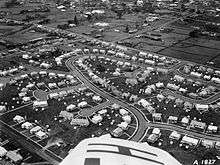Economic inequality in New Zealand
Economic inequality in New Zealand is one of the social issues related to that country.

Between 1982 and 2011, New Zealand's gross domestic product grew by 35%. Almost half of that increase went to a small group who were already the richest in the country. During this period, the average income of the top 10% of earners in New Zealand (those earning more than $72,000)[1] almost doubled going from $56,300 to $100,200. The average income of the poorest tenth increased by 13% from $9700 to $11,000.[2]
Growing inequality is confirmed by Statistics New Zealand which keeps track of income disparity using the P80/20 ratio. This ratio shows the difference between high household incomes (those in the 80th percentile) and low household incomes (those in the 20th percentile). The inequality ratio increased between 1988 and 2004, and decreased until the onset of the Global Financial Crisis in 2008, increasing again to 2011 and then declining again from then. By 2013, the disposable income of high-income households was more than two-and-a-half times larger than that of low-income households.[3] Highlighting the disparity, the top 1% of the population now owns 16% of the country's wealth – the richest 5% owns 38%[4] – while half the population, including beneficiaries and pensioners, earn less than $24,000.[1]
See also
References
- "NZ income gap at crisis level". Stuff.co.nz. 19 September 2013.
- "Paradise for a few". The New Zealand Herald. 22 June 2013.
- "New Zealand Progress Indicators:Income inequality". Statistics New Zealand. August 2014. Retrieved 22 December 2014.
- "Brian Fallow: Wealth gap goes mainstream". The New Zealand Herald. 24 October 2014.
- "The equality debate: Inequality in NZ under spotlight". The New Zealand Herald. 13 May 2014.
- Paul Barber. "The Spirit Level for New Zealand". "Closer Together" NZCCSS.
- "'Spirit Level' authors to speak in Dunedin". Otago Daily Times. 23 May 2014.
- Wasserman, Danuta; Cheng, Qi; Jiang, Guo-Xin (1 June 2005). "Global suicide rates among young people aged 15–19". World Psychiatry. 4 (2): 114–20. PMC 1414751. PMID 16633527.
- "Rogernomics and Rupture: Huntly's Response to the Corporatisation of State Coal Mines in 1987". Ir.canterbury.ac.nz. Retrieved 2018-09-05.
- "Suicide Facts: 2015 data". Ministry of Health NZ. Retrieved 2018-12-24.
- Ballard, Keith (2003-10-14). "Inclusion, exclusion, poverty, racism and education: An outline of some present issues". Archived from the original (DOC) on 22 May 2010. Cite journal requires
|journal=(help) - "Crime Statistics for calendar year ending 31 December 2014".
- "Health Expenditure Trends in New Zealand 2000–2010".
- "Archived copy" (PDF). Archived from the original (PDF) on 4 March 2016. Retrieved 26 August 2015.CS1 maint: archived copy as title (link)
- Federico Cingano (December 2014). "OECD Social, Employment and Migration Working Papers No. 163 – Trends in Income Inequality and its Impact on Economic Growth" (PDF). OECD. Retrieved 11 December 2014.
- "OECD income inequality gap widest in 30 years". TV3 News. 9 December 2014. Archived from the original on 11 December 2014. Retrieved 10 December 2014.
- "Income inequality stunts NZ growth – OECD". The New Zealand Herald. 10 December 2014.
- "Home – Child Poverty Monitor". www.childpoverty.co.nz.
- "NZ's child poverty rate one of highest". The New Zealand Herald. 2 March 2005.
- "Facts About Poverty in 2009". New Zealand Council of Christian Social Services.
- "One in four Kiwi children living in poverty". The Dominion Post. 9 December 2013.
- "Measuring child poverty in New Zealand: Issues and practicalities, Paper prepared for the Expert Advisory Group on Solutions to Child Poverty" (PDF). Statistics New Zealand.
- "Data on Poverty in New Zealand" (PDF). New Zealand Treasury. p. para 7. Archived from the original (PDF) on 13 January 2015.
- Kieran Madden. "The Heart of Poverty" (PDF). Maxim Institute.
- "Solutions to Child Poverty in New Zealand: Evidence for Action" (PDF).
- "Child Poverty Monitor".